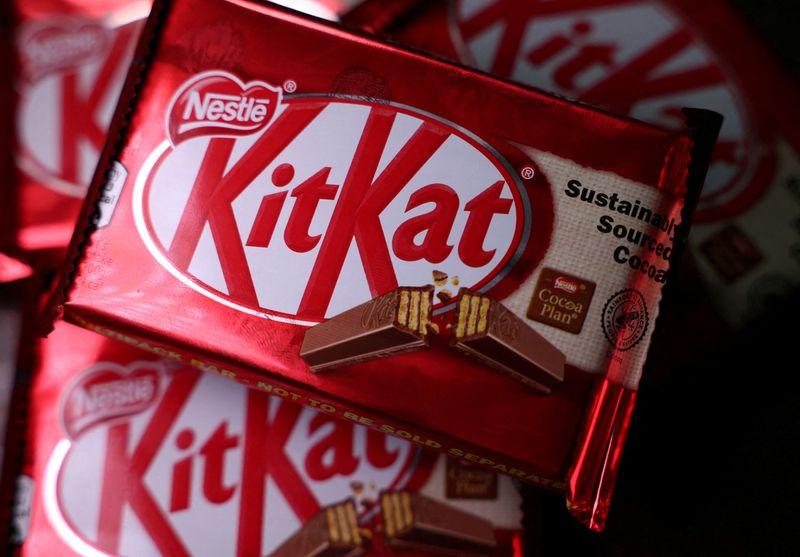By Richa Naidu
LONDON (Reuters) – Nestle’s plans under new CEO Laurent Freixe to restructure and sharpen its focus on its top brands were welcomed by investors, but executing a turnaround strategy against a backdrop of weak consumer demand will be a tough task.
After replacing Mark Schneider as CEO last month, Freixe set out plans on Thursday to revamp the executive board, revive Nestle’s core 31 “billionaire brands”, become price competitive again and win back market share through innovation and marketing.
He relayed his strategy to investors as Nestle – owner of brands including Nescafe, Kit Kat, Sanpellegrino and Purina pet food – cut its full-year sales outlook after weaker than expected nine-month organic sales growth.
Freixe told an investor call that Nestle is operating in “an environment characterized by softening consumer demand,” particularly in North America and Europe, the company’s biggest markets.
In the first nine months of the year, the Swiss-based group was only able to raise prices by 0.6% in North America, where its products sell at retailers from Walmart (NYSE:WMT) to Kroger (NYSE:KR).
In Europe, grocers are becoming harder to negotiate with and several products were taken off shelves in the third quarter, the company said.
“Freixe clearly has his work cut out to improve these weak
trends,” Bernstein analyst Callum Elliott said. “Is this weakness really about executional struggles for Nestle… or are these growth challenges just a reflection of the weak growth backdrop in Nestle’s categories and an ongoing strategic dilemma facing the world’s biggest food company?”
It has been a tumultuous two years for the industry as the end of the Covid-19 pandemic triggered a supply chain crunch and sky-high commodities prices followed by soaring energy prices after Russia invaded Ukraine, and disruptions due to attacks on container ships in the Red Sea.
Since the start of 2022, when Schneider split Nestle into five geographical regions in what it called a market-led approach, shares in Nestle have fallen by about a third. Freixe will now cut the number of regions to three to simplify the structure.
“Freixe came across well and made the right noises,” Barclays analyst Warren Ackerman said. “However, U.S., Europe and Latin America are under pressure, so this is not an easy backdrop to execute a turnaround.”
‘HE’S A LIFER’
Schneider was ousted from Nestle in August with little notice after several straight quarters of weak sales volume growth, with total revenue propped up by high pricing to cover rising costs. The group started cutting back on marketing and innovation, despite investor anxiety over doing so.
Shoppers turned to cheaper brands and by this year when Nestle began slowing down price hikes, many of its brands were not innovative or well marketed enough to win back sales.
Investors and analysts seem encouraged by Freixe’s turnaround plans however, with Nestle’s shares rising about 2% on Thursday despite the group cutting its full-year outlook.
“He’s a lifer, isn’t he?” Ben Lofthouse, Janus Henderson’s head of global equity income, said. “I think he’s been at Nestle 40-odd years. He’s just come back from Latin America to try and stabilize the ship.”
Vontobel analyst Jean-Philippe Bertschy believes there will be brand disposals ahead.
Nestle, which also makes Quality Street chocolates and Haagen Dazs ice cream, has in recent quarters geared itself towards its “billionaire brands” – its 31 biggest brands.
The rhetoric has been similar to that of rival food and consumer group Unilever (LON:ULVR) which, under CEO Hein Schumacher, has been focusing on its top 30 brands out of roughly 400. In Unilever’s case, the strategy has sparked speculation that the company may struggle to sell off unwanted brands – a task that might be harder for Nestle, which has over 2,000 brands. The company’s sales growth this year has been driven by coffee, petcare and confectionery, where it has innovative new products.
Nestle’s top brands’ market share “improved” in the third quarter, Freixe said, though “overall market share for the total group was broadly in line with the first half.” Fixing this is a “key priority,” he added.
Investors will have to be patient, said Barclays’ Ackerman. Next year will be “a transitional year with the second consecutive year of negative earnings growth,” he said.
“Investors will need to look beyond 2025.”

